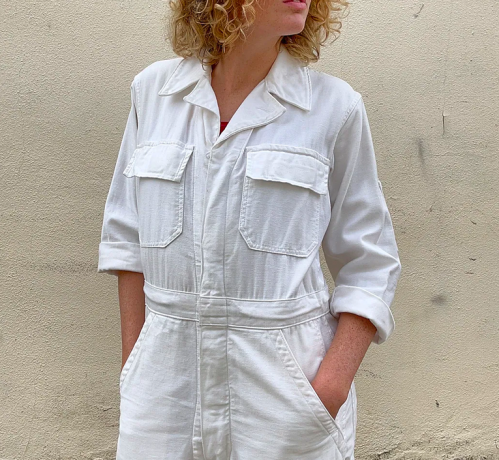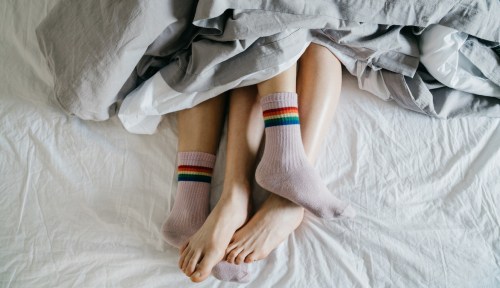Real talk: You want to be a totally chic, vintage-vibing thrift shopper, but the thought of sifting through countless racks of one-of-a-kind finds—plus keeping up with the other shoppers who somehow seem to have it down—is all kinds of overwhelming. Sticking to fast fashion and overnight shipping is very tempting.
Don’t throw in the towel. For one thing, thrifting is the ticket to all the unduplicated, uniquely you ‘fits of your dreams—and the most satisfying answer to the inevitable “OMG, where did you get that?” Beyond just an enviable aesthetic, though, secondhand shopping is the most planet-friendly way to grow your wardrobe (even more than buying from sustainable brands), because you’re avoiding clothing production and keeping old threads out of landfills.
To tackle the racks with low stress and high reward, crafting a plan is key. The best place to start when it comes to navigating any thrift store? As you peruse, take slow-fashion pro Sally Garcia’s advice and check every fabric label. Then, filter by high-quality, natural materials like cotton, which is durable, versatile, and naturally grown (aka everything you want in a vintage find).
Ready to hit the secondhand circuit? Keep reading for more expert intel on why the fabric label is a thrifting essential, tips on how to navigate any shop without getting overwhelmed, and a few swoon-worthy, pre-loved gems you can snag online.
Why checking the fabric label is key
The caliber of your clothing is important—both for the durability of your wardrobe and for the stewardship of the planet—but vintage items can sometimes leave you guessing on quality. That’s why, according to Garcia, familiarizing yourself with fabrics is a solid first step in upping your thrifting game. Start by checking the label, opting for natural fibers (like cotton) over synthetics and blends, and giving every piece a poke and prod. “Just by feeling the item, I can tell if it’s something I’m going to reach for often or not,” she says.
The fabric label also acts as a window into the history of every secondhand steal, Garcia says, connecting you to its origin and what it took to land on the rack. “It’s so easy to walk into a store and buy whatever you want without thinking about who made the item…and how that article of clothing is affecting the planet.”
When you set your sights on secondhand pieces made with high-quality fibers, you’re supporting sustainable and ethical practices, she says—and you’re honing your thrifting skills while you’re at it.
Making the case for cotton
Sticking to vintage items made with natural fibers is a straightforward way to zero in on the keepers—but exactly why is cotton so key? Beyond feeling soft like a hug from an old friend every time you slip on a workout tee or a breezy dress, cotton is breathable, versatile, and timeless—plus hypoallergenic, easy to clean, and seriously durable (so yes, you’ll see a lot of it among the vintage racks).
Cotton is Garcia’s favorite fabric, and it has some serious staying power in her closet. She loves the way it wears over time and, while she’s not quick to toss any of her favorite cotton comfies, she appreciates that the fabric biodegrades more easily than many others and, because it’s plant-based and nurtured by rainfall, it doesn’t contribute to widespread microplastic pollution. So that retro cotton jumpsuit you stumbled upon was a sustainable choice before it even got the secondhand seal of approval. It’s a win-win.
More pro tips for navigating the racks
With label-checking as your tried-and-true first step, commit a few more of Garcia’s vintage tips to memory. To ensure you’re sticking to quality items—and avoiding a total stress fest—stick to a shopping list. “You might not find everything in one trip,” Garcia says, “but this will keep you from buying things you don’t need.”
Most importantly, keep your mind open and your creativity flowing, she says. If you’re feeling up to it, “go through all the racks. Men’s clothes, kids’ clothes, accessories, everything! Thrifting allows you to explore your style more, so don’t be afraid to step outside of your comfort zone.” And her signature move? “Don’t forget to check the end of the rack, which is where you’re likely to find leave-behinds from other [shoppers].”
With a few of these strategies stashed in your thrifting toolkit, you can actually have fun secondhand shopping (and end up with a generations-old cotton staple or two), totally stress-free.
Shop Vintage Finds

UO Urban Renewal Oversized Light Green Denim Long Sleeve $49

Levi’s Lightning Dye Denim Shorts $79

Urban Renewal Pieced Denim Mini Skirt $59

Madewell White Workwear Coveralls $238

Urban Renewal Remade Carhartt Pants $99

Madewell Vintage Chore Coat $95

Free People We the Free Sashiko Tote $138

ASOS 80s Black Cotton Maxi Dress $32
Sign up for the Well+Good SHOP Newsletter
Get exclusive deals on wellness, beauty, fitness, and food products that have been hand-picked by our editors.
Got it, you've been added to our email list.





